您的位置:上海毫米网络优化公司 > 网站优化分享 >
相关推荐recommended
- MyBatisPlus(SpringBoot版)的分页插件
- 1.5MHz,1.2A COT 架构同步降压变换器只要0.16元,型号
- 【爬虫实战】Python爬取知网文献信息
- 深度解析 Spring 源码:三级缓存机制探究
- 【接口测试】常见HTTP面试题
- 【MySQL】内外连接——内连接、外连接、左外连接、右外连接、内外连接
- mysql中SUBSTRING
- 云计算基础、Issa、Pssa、Saas区别
- 快速入门Spring Data JPA
- 14.网络爬虫—数据提取2-正则表达式规则详讲
- Python赋能AI数据分析开启人工智能新时代
- SQL IFNULL()函数简介
- SpringBoot集成Nacos
- mysql如何自定义自增主键值,以及所遇到的不生效问题
- python——Django 框架
- SpringBoot整合Minio的详细步骤
- Springboot数据加密篇
- Spring Boot启动时执行初始化操作的几种方式
- 神州云服务平台(型号:DCC-CRL1000)基本配置教学视频
- Windows下搭建Tomcat HTTP服务,发布外网远程访问
- 云计算——ACA学习 阿里云云计算服务概述
- Rust面试宝典第4题:打家劫舍
- 【Spring】spring中怎么解决循环依赖的问题
- Postman测试金蝶云星空Webapi【协同开发云】
- XGBOOST算法Python实现(保姆级)
- Leetcode-二叉树oj题
- Node-sass与Node.js版本对应关系的深入探讨
- com.google.common.collect 是 Google
- 项目启动报错:If you want an embedded data
- 基于Django美食菜谱网站和点评系统设计与实现(Pycharm+Py
Springboot之自定义注解
作者:mmseoamin日期:2024-04-29
提示:文章写完后,目录可以自动生成,如何生成可参考右边的帮助文档
Springboot
- 一、自定义注解简介
- 1.Java注解简介
- 1.1Java注解分类
- 1.2JDK基本注解
- 1.3JDK元注解
- 1.4自定义注解
- 2.反射机制(java.Reflection)
- 2.1、静态语言 VS 动态语言
- 二、自定义注解的案列
- 2.1.创建SpringBoot项目
- 2.1.1.点击New Project
- 2.1.2.创建新项目
- 2.1.3.创建一个新的Module
- 2.1.4.创建SpringBoot模块
- 2.1.5.项目创建完成
- 2.2.修改pom.xml
- 2.3.案例一
- 2.3.1.新建一个annotation包
- 2.3.2.添加TranscationModel枚举类
- 2.3.3.新建MyAnnotation1注解
- 2.3.4.新建MyAnnotation2注解
- 2.3.5.新建MyAnnotation3注解
- 2.3.6.新建Demo类
- 2.3.7.新建DemoTest类
- 2.7.8.运行结果:
- 2.4. 案例二(获取类属性上的注解属性值)
- 2.5.案例三(获取参数修饰注解对应的属性值)
- 三、spring aop集成自定义注解实现日志记录功能
- 3.1.在pom.xml中添加依赖
- 3.2.自定义注解
- 3.3.定义切面类
- 3.4.新建LogController
- 3.5.新建LogControllerTest
- 3.6.运行结果:
- 4.6.MyLogAspect中添加内容
- 4.7.修改LogController.java
- 4.8.修改LogConterollerTest.java
- 4.9运行结果:
- 总结
一、自定义注解简介
1.Java注解简介
Java注解是附加在代码中的一些元信息,用于一些工具在编译、运行时进行解析和使用,起到说明、配置的功能。
注解相关类都包含在java.lang.annotation包中。
1.1Java注解分类
基本注解 元注解 自定义注解
1.2JDK基本注解
@Override 重写 @SuppressWarnings(value = "unchecked") 压制编辑器警告
1.3JDK元注解
@Retention:定义注解的保留策略 @Retention(RetentionPolicy.SOURCE) //注解仅存在于源码中,在class字节码文件中不包含 @Retention(RetentionPolicy.CLASS) //默认的保留策略,注解会在class字节码文件中存在,但运行时无法获得, @Retention(RetentionPolicy.RUNTIME) //注解会在class字节码文件中存在,在运行时可以通过反射获取到 @Target:指定被修饰的Annotation可以放置的位置(被修饰的目标) @Target(ElementType.TYPE) //接口、类 @Target(ElementType.FIELD) //属性 @Target(ElementType.METHOD) //方法 @Target(ElementType.PARAMETER) //方法参数 @Target(ElementType.CONSTRUCTOR) //构造函数 @Target(ElementType.LOCAL_VARIABLE) //局部变量 @Target(ElementType.ANNOTATION_TYPE) //注解 @Target(ElementType.PACKAGE) //包 注:可以指定多个位置,例如: @Target({ElementType.METHOD, ElementType.TYPE}),也就是此注解可以在方法和类上面使用 @Inherited:指定被修饰的Annotation将具有继承性 @Documented:指定被修饰的该Annotation可以被javadoc工具提取成文档. ## 2.读入数据其中最重要的是
@Retention(RetentionPolicy.RUNTIME) @Target:指定被修饰的Annotation可以放置的位置(被修饰的目标)
1.4自定义注解
注解分类(根据Annotation是否包含成员变量,可以把Annotation分为两类):
标记Annotation:
没有成员变量的Annotation; 这种Annotation仅利用自身的存在与否来提供信息
元数据Annotation:
包含成员变量的Annotation; 它们可以接受(和提供)更多的元数据;
2.反射机制(java.Reflection)
反射最重要的就是类类,一切反射的基础是类类
2.1、静态语言 VS 动态语言
动态语言
是一类在运行时可以改变其结构的原因:例如新的函数、对象、甚至代码可以被引进,已有的函数可以被删除或是其他结构上的变化。通俗点说就是在运行时代码可以根据某些条件改变自身结构
主要动态语言:Object-c、C#、JavaScript、php、Python等
静态语言
与动态语言相对应的,运行时结构不可变的语言就是静态语言。如Java、C、C++。
Java不是动态语言,但Java可以称之为"准动态语言"。即Java有一定的动态性,我们可以利用反射机制获得类似语言的特性。Java的动态性让编程的时候更加灵活!
二、自定义注解的案列
2.1.创建SpringBoot项目
PS: 后面还要使用到, 所以这里创建一个空的项目,通过创建模块的方式完成
2.1.1.点击New Project
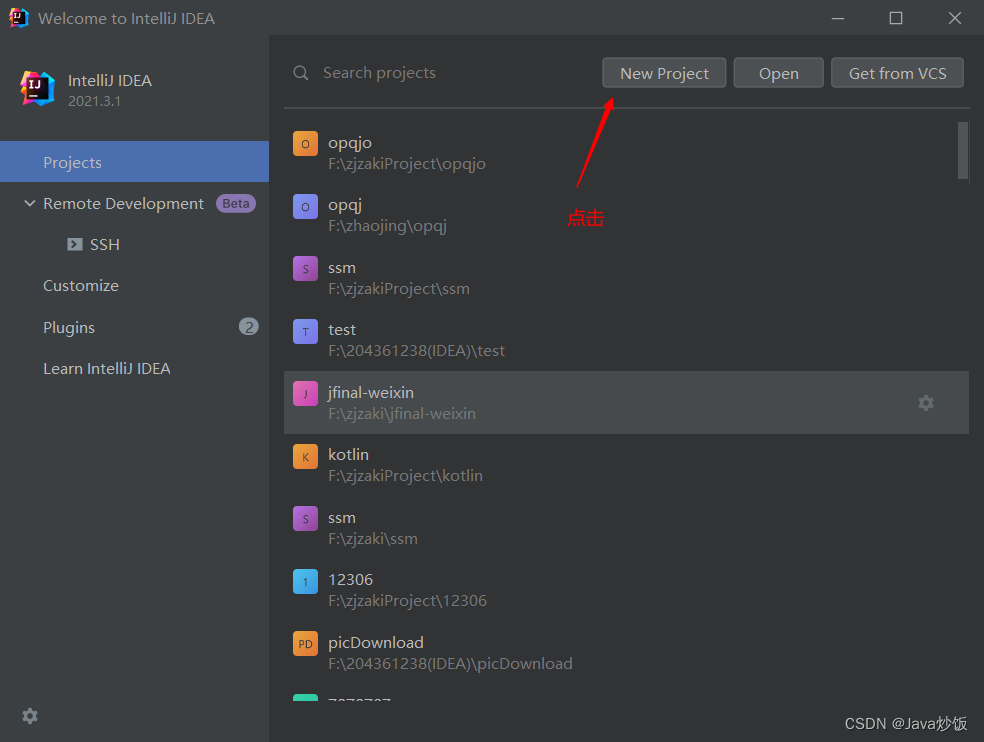
2.1.2.创建新项目
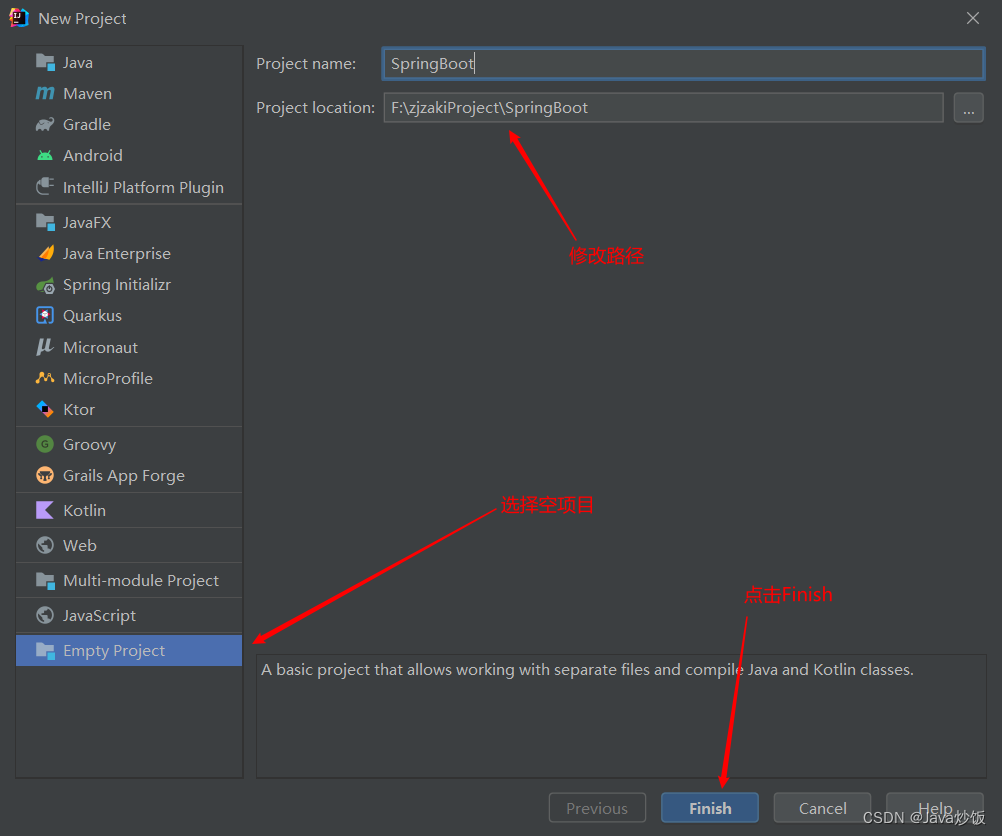
2.1.3.创建一个新的Module
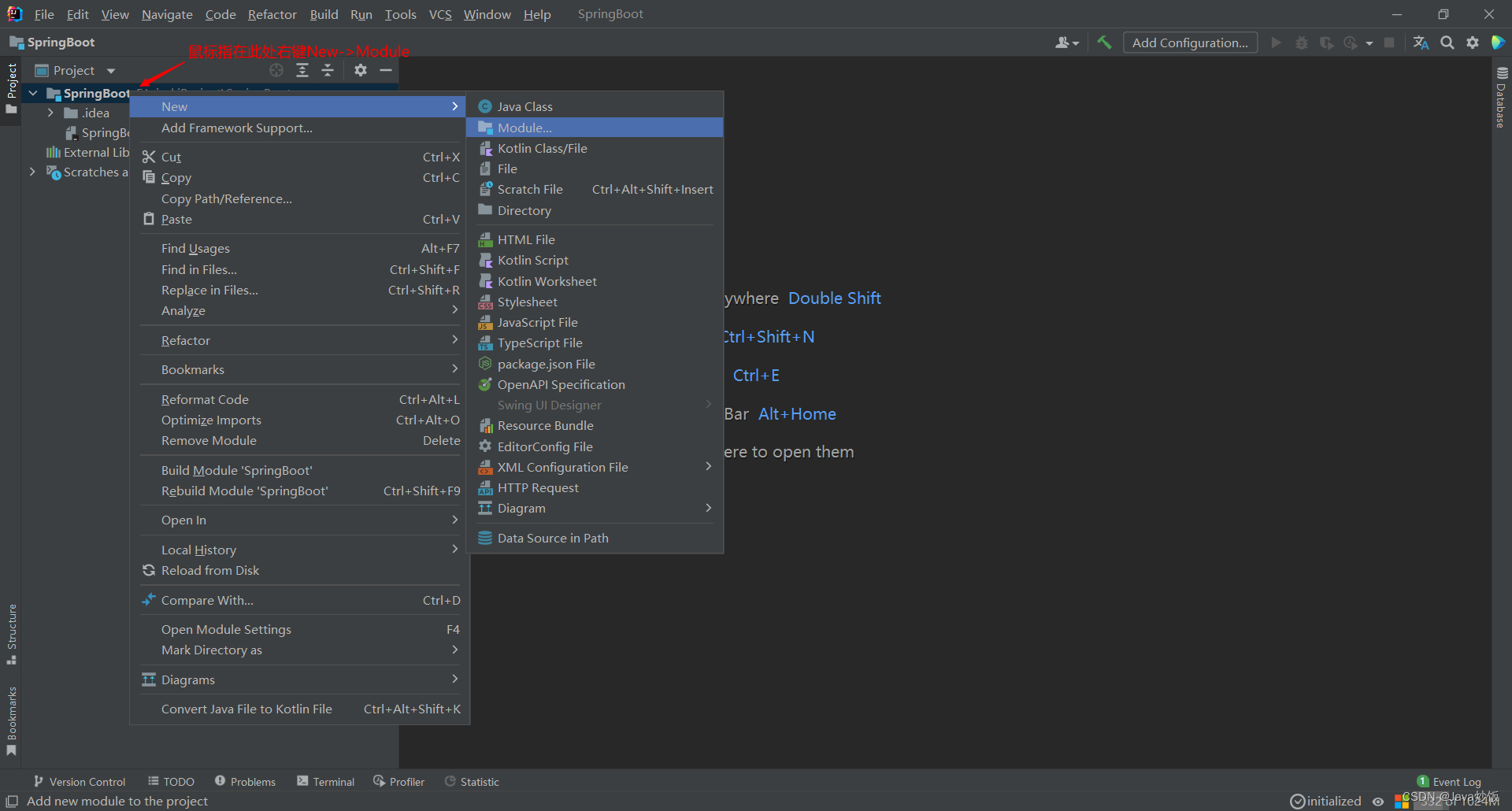
2.1.4.创建SpringBoot模块
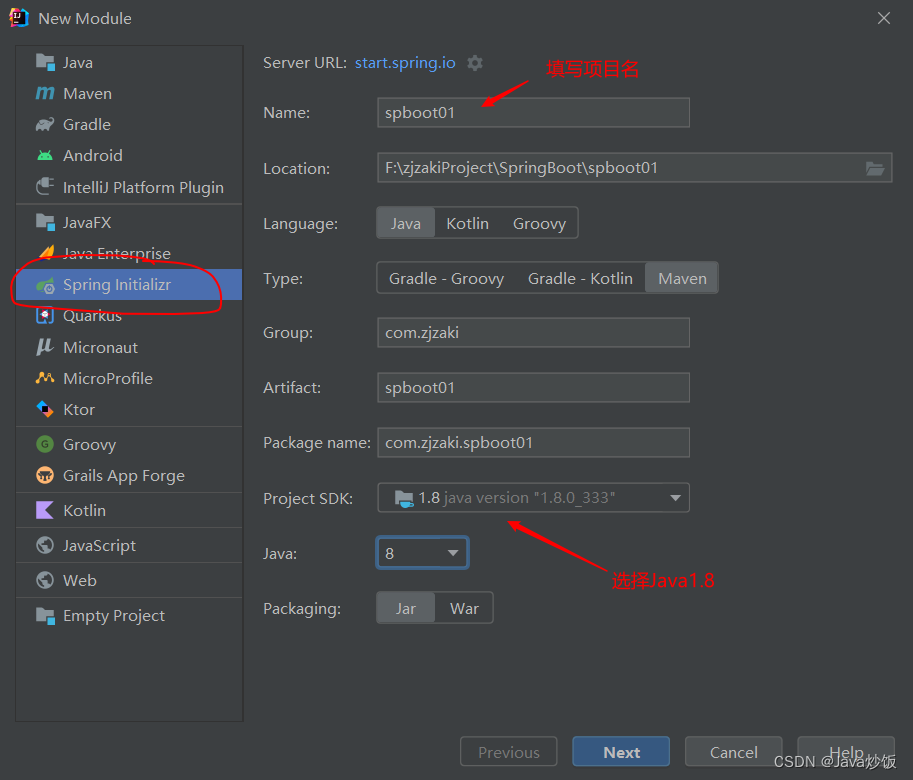
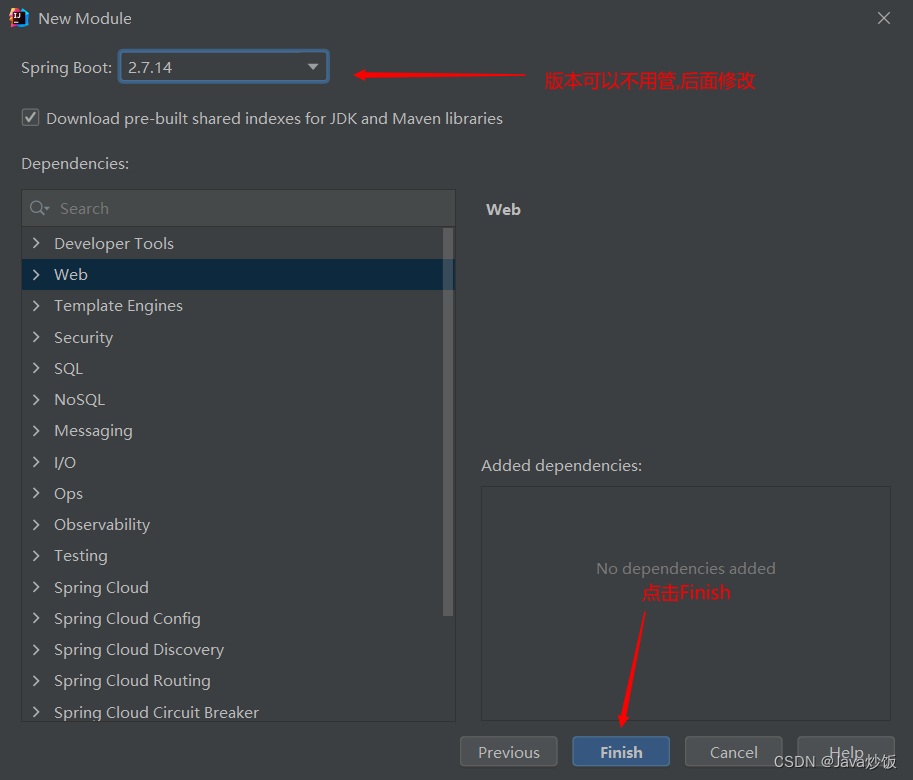
2.1.5.项目创建完成
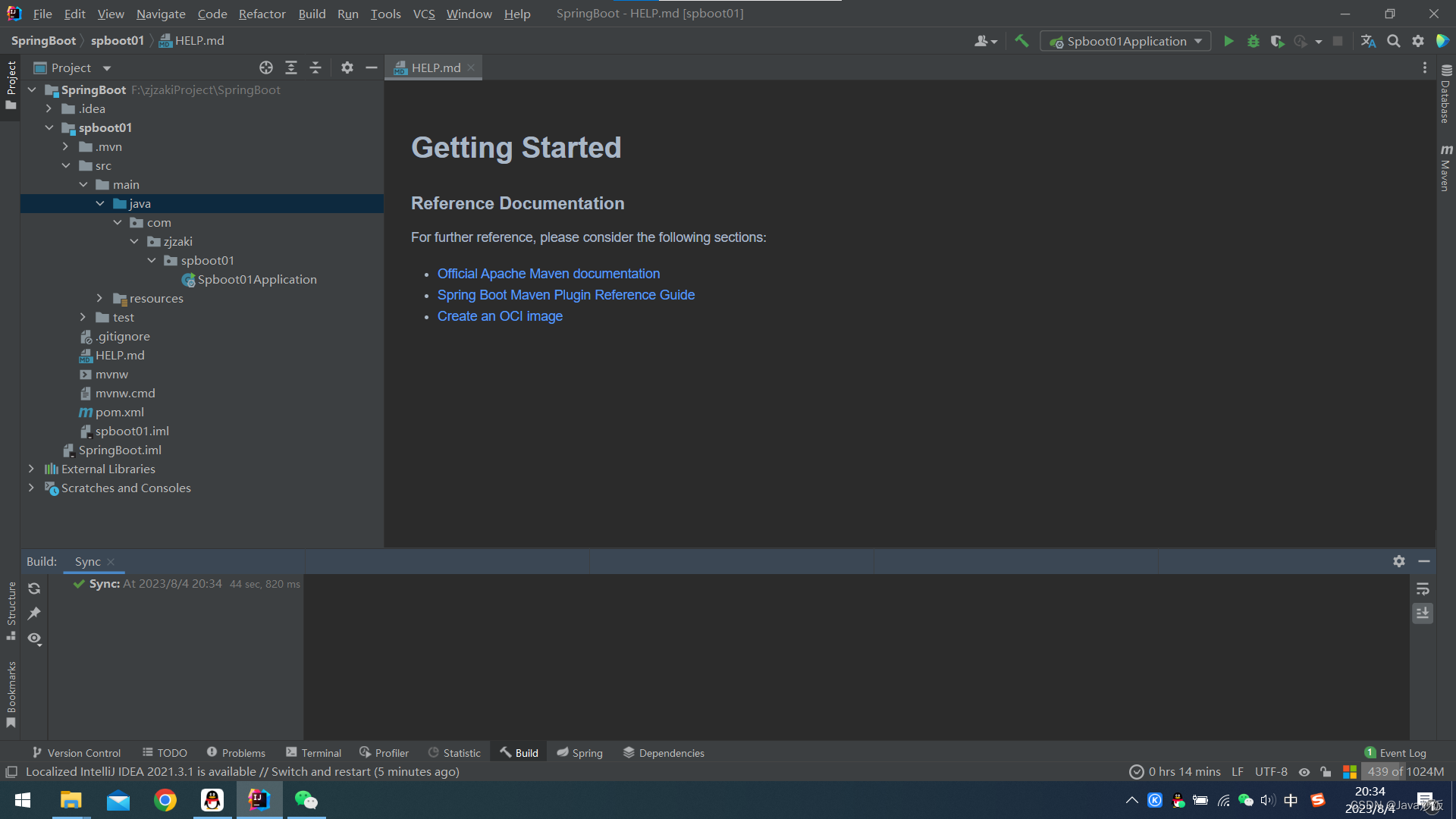
2.2.修改pom.xml
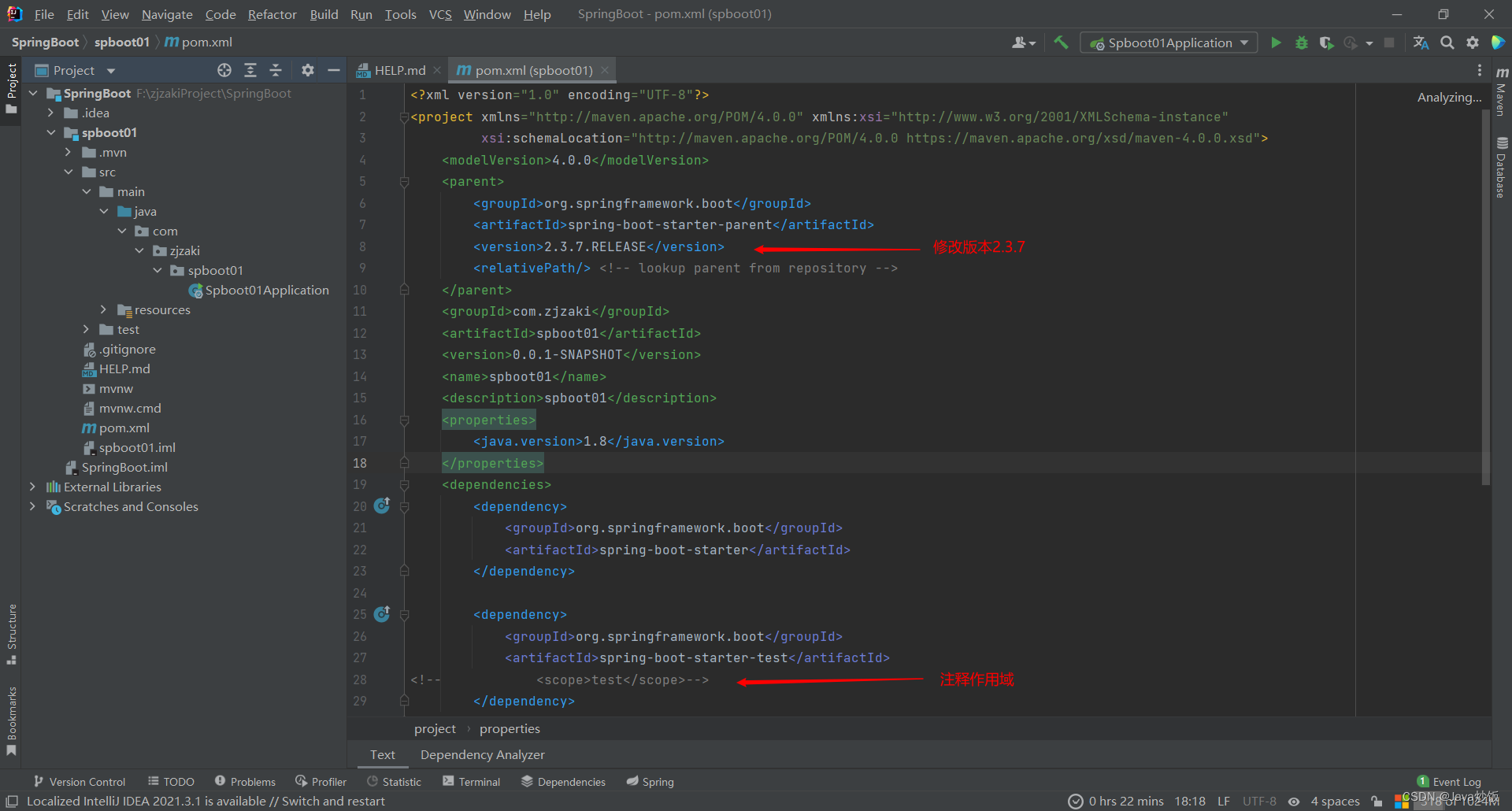
2.3.案例一
2.3.1.新建一个annotation包
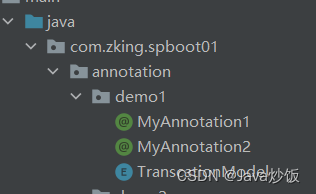
2.3.2.添加TranscationModel枚举类
package com.zking.spboot01.annotation.demo1; public enum TranscationModel { Read, Write, ReadWrite }2.3.3.新建MyAnnotation1注解
package com.zking.spboot01.annotation.demo1; import java.lang.annotation.Documented; import java.lang.annotation.ElementType; import java.lang.annotation.Target; @Retention(RetentionPolicy.RUNTIME) @Target({ElementType.TYPE,ElementType.FIELD,ElementType.METHOD}) @Documented public @interface MyAnnotation1 { String name(); }2.3.4.新建MyAnnotation2注解
package com.zking.spboot01.annotation.demo1; import java.lang.annotation.*; /** * MyAnnotation2注解可以用在方法上 * 注解运行期也保留 * 不可继承 */ @Target(ElementType.METHOD) @Retention(RetentionPolicy.RUNTIME) @Documented public @interface MyAnnotation2 { TranscationModel model() default TranscationModel.ReadWrite; }2.3.5.新建MyAnnotation3注解
package com.zking.annotation.pi; import java.lang.annotation.*; /** * * MyAnnotation3注解可以用在方法上 * 注解运行期也保留 * 可继承 */ @Target(ElementType.METHOD) @Retention(RetentionPolicy.RUNTIME) @Inherited @Documented public @interface MyAnnotation3 { TranscationModel[] models() default TranscationModel.ReadWrite; }2.3.6.新建Demo类
package com.zking.annotation.pi; /** * * 获取类与方法上的注解值 */ @MyAnnotation1(name = "abc") public class Demo1 { @MyAnnotation1(name = "xyz") private Integer age; @MyAnnotation2(model = TranscationModel.Read) public void list() { System.out.println("list"); } @MyAnnotation3(models = {TranscationModel.Read, TranscationModel.Write}) public void edit() { System.out.println("edit"); } }2.3.7.新建DemoTest类
package com.zking.annotation.pi; import org.junit.Test; /** */ public class Demo1Test { @Test public void list() throws Exception { // 获取类上的注解 MyAnnotation1 annotation1 = Demo1.class.getAnnotation(MyAnnotation1.class); System.out.println(annotation1.name());//abc // 获取方法上的注解 MyAnnotation2 myAnnotation2 = Demo1.class.getMethod("list").getAnnotation(MyAnnotation2.class); System.out.println(myAnnotation2.model());//Read // 获取属性上的注解 MyAnnotation1 myAnnotation1 = Demo1.class.getDeclaredField("age").getAnnotation(MyAnnotation1.class); System.out.println(myAnnotation1.name());// xyz } @Test public void edit() throws Exception { MyAnnotation3 myAnnotation3 = Demo1.class.getMethod("edit").getAnnotation(MyAnnotation3.class); for (TranscationModel model : myAnnotation3.models()) { System.out.println(model);//Read,Write } } }2.7.8.运行结果:
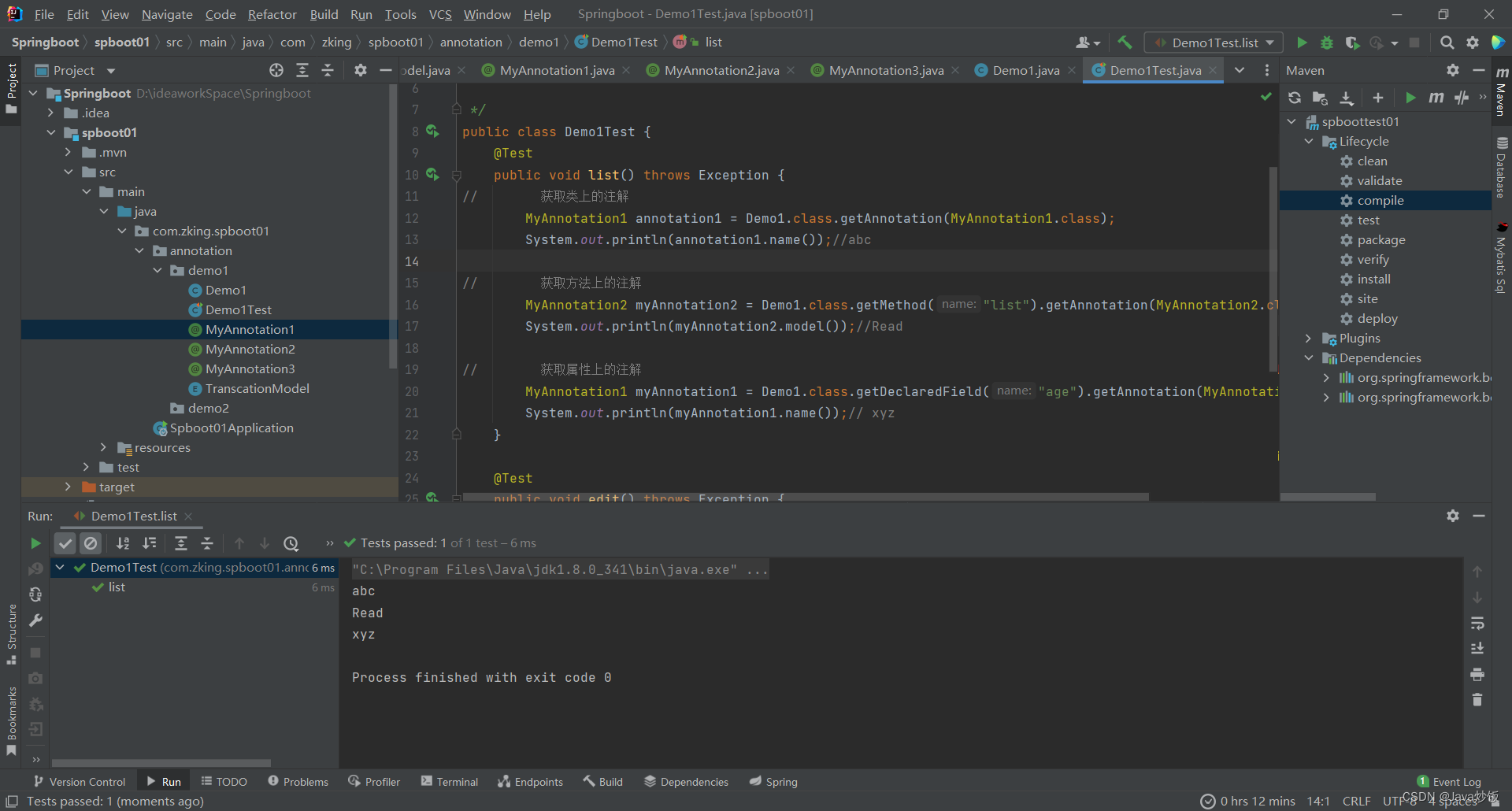
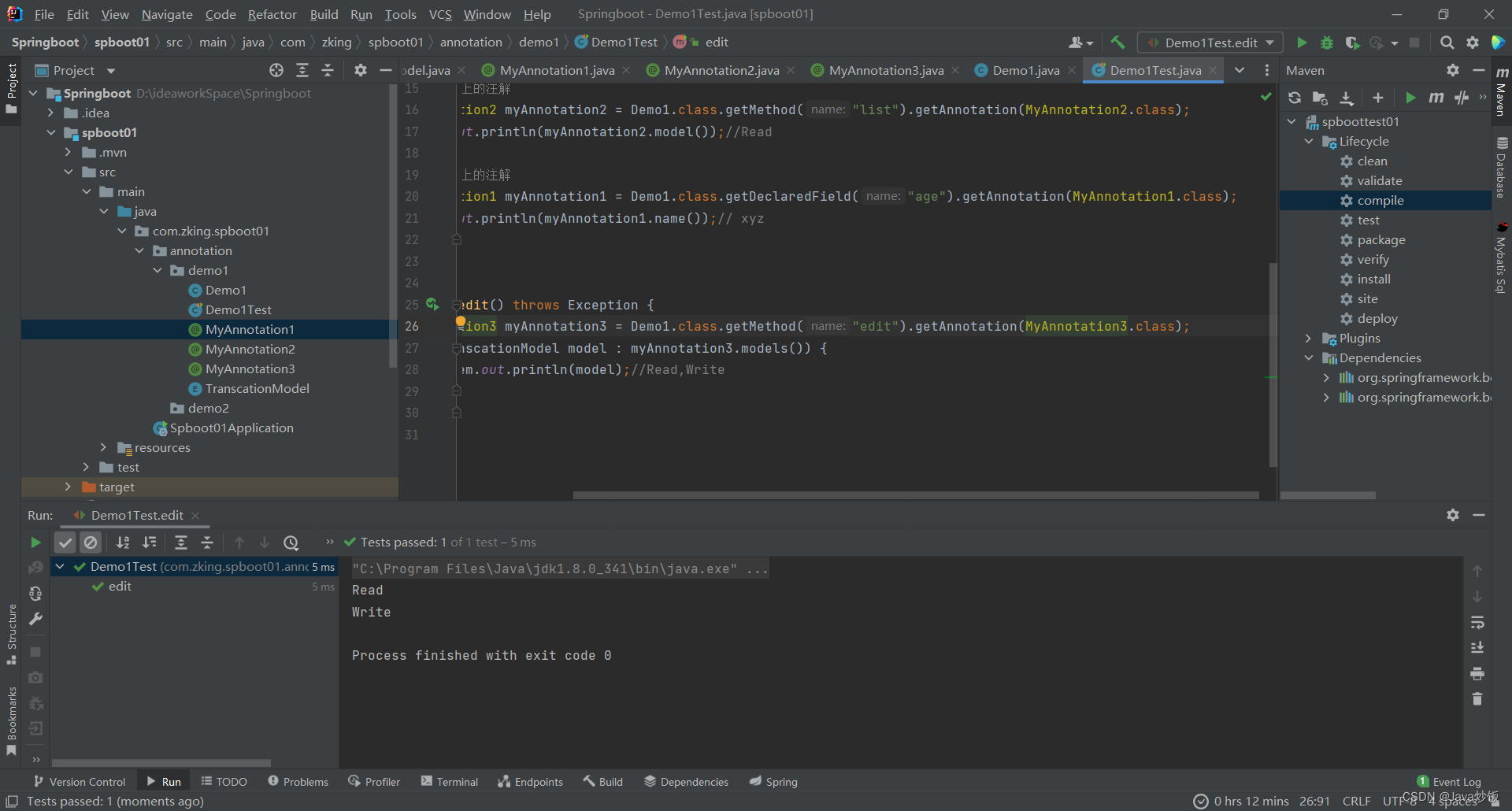
2.4. 案例二(获取类属性上的注解属性值)
2.4.1.新建demo02包
2.4.2.新建TestAnnotation注解
package com.zking.spboot01.annotation.demo2; import java.lang.annotation.ElementType; import java.lang.annotation.Retention; import java.lang.annotation.RetentionPolicy; import java.lang.annotation.Target; /** */ //@Retention(RetentionPolicy.SOURCE) @Retention(RetentionPolicy.RUNTIME) @Target(ElementType.FIELD) public @interface TestAnnotation { String value() default "默认value值"; String what() default "这里是默认的what属性对应的值"; }2.4.3.新建Demo2类
package com.zking.spboot01.annotation.demo2; /** * * 获取类属性上的注解属性值 */ public class Demo2 { @TestAnnotation(value = "这就是value对应的值_msg1", what = "这就是what对应的值_msg1") private static String msg1; @TestAnnotation("这就是value对应的值1") private static String msg2; @TestAnnotation(value = "这就是value对应的值2") private static String msg3; @TestAnnotation(what = "这就是what对应的值") private static String msg4; }2.4.4.新建Demo2Test
package com.zking.spboot01.annotation.demo2; import org.junit.Test; /** */ public class Demo2Test { @Test public void test1() throws Exception { TestAnnotation msg1 = Demo2.class.getDeclaredField("msg1").getAnnotation(TestAnnotation.class); System.out.println(msg1.value()); System.out.println(msg1.what()); } @Test public void test2() throws Exception{ TestAnnotation msg2 = Demo2.class.getDeclaredField("msg2").getAnnotation(TestAnnotation.class); System.out.println(msg2.value()); System.out.println(msg2.what()); } @Test public void test3() throws Exception{ TestAnnotation msg3 = Demo2.class.getDeclaredField("msg3").getAnnotation(TestAnnotation.class); System.out.println(msg3.value()); System.out.println(msg3.what()); } @Test public void test4() throws Exception{ TestAnnotation msg4 = Demo2.class.getDeclaredField("msg4").getAnnotation(TestAnnotation.class); System.out.println(msg4.value()); System.out.println(msg4.what()); } }2.4.5运行结果:
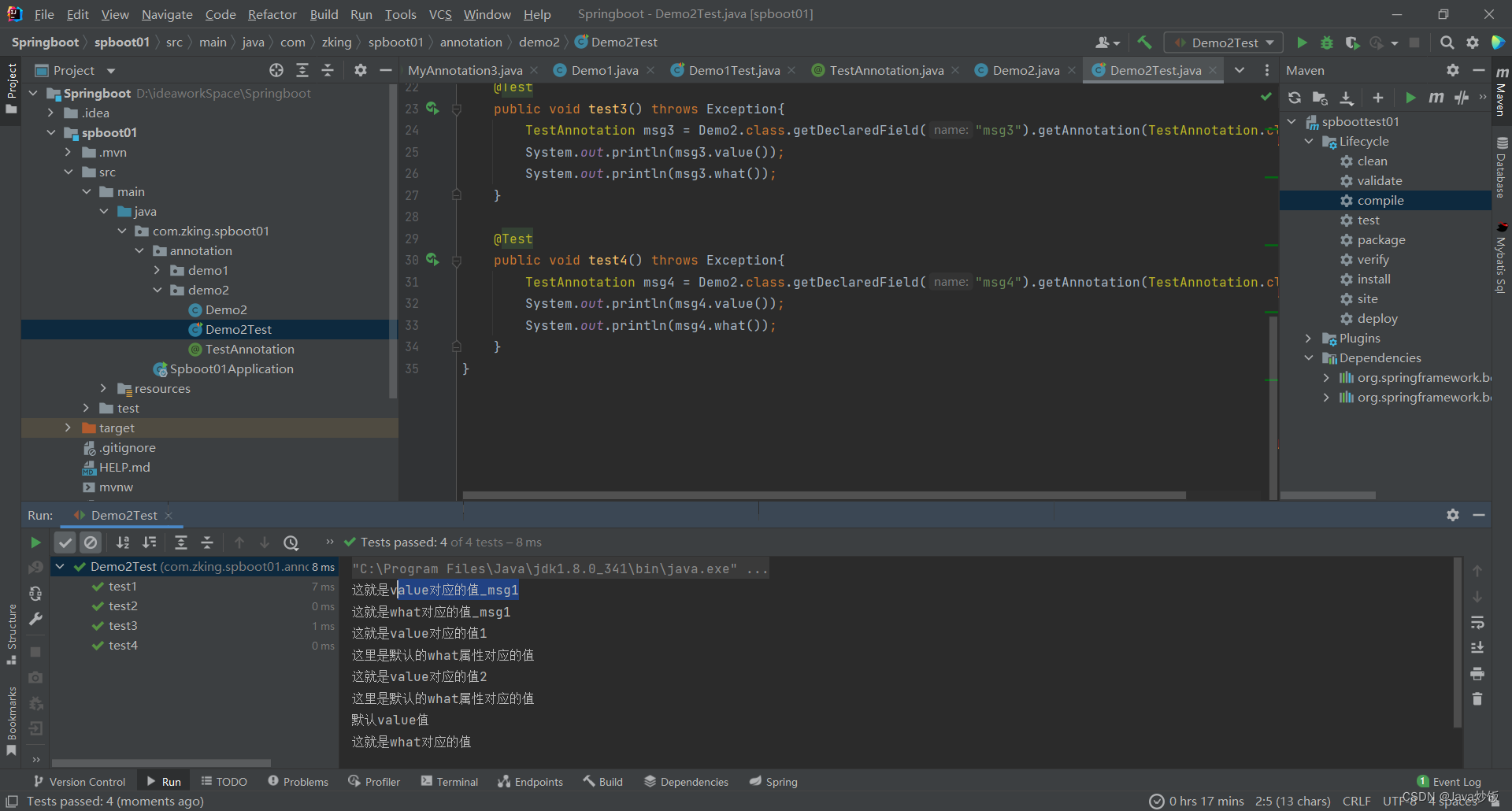
2.5.案例三(获取参数修饰注解对应的属性值)
package com.zking.spboot01.annotation.demo3; import java.lang.annotation.*; /** * * 非空注解:使用在方法的参数上,false表示此参数可以为空,true不能为空 */ @Documented @Target({ElementType.PARAMETER}) @Retention(RetentionPolicy.RUNTIME) public @interface IsNotNull { boolean value() default false; }package com.zking.spboot01.annotation.demo3; /** * * 获取参数修饰注解对应的属性值 */ public class Demo3 { public void hello1(@IsNotNull(true) String name) { System.out.println("hello:" + name); } public void hello2(@IsNotNull String name) { System.out.println("hello:" + name); } }package com.zking.spboot01.annotation.demo3; import org.junit.Test; import java.lang.reflect.Parameter; /** */ public class Demo3Test { @Test public void hello1() throws Exception { Demo3 demo3 = new Demo3(); for (Parameter parameter : demo3.getClass().getMethod("hello1", String.class).getParameters()) { IsNotNull annotation = parameter.getAnnotation(IsNotNull.class); if(annotation != null){ System.out.println(annotation.value());//true } } } @Test public void hello2() throws Exception { Demo3 demo3 = new Demo3(); for (Parameter parameter : demo3.getClass().getMethod("hello2", String.class).getParameters()) { IsNotNull annotation = parameter.getAnnotation(IsNotNull.class); if(annotation != null){ System.out.println(annotation.value());//false } } } }运行结果:
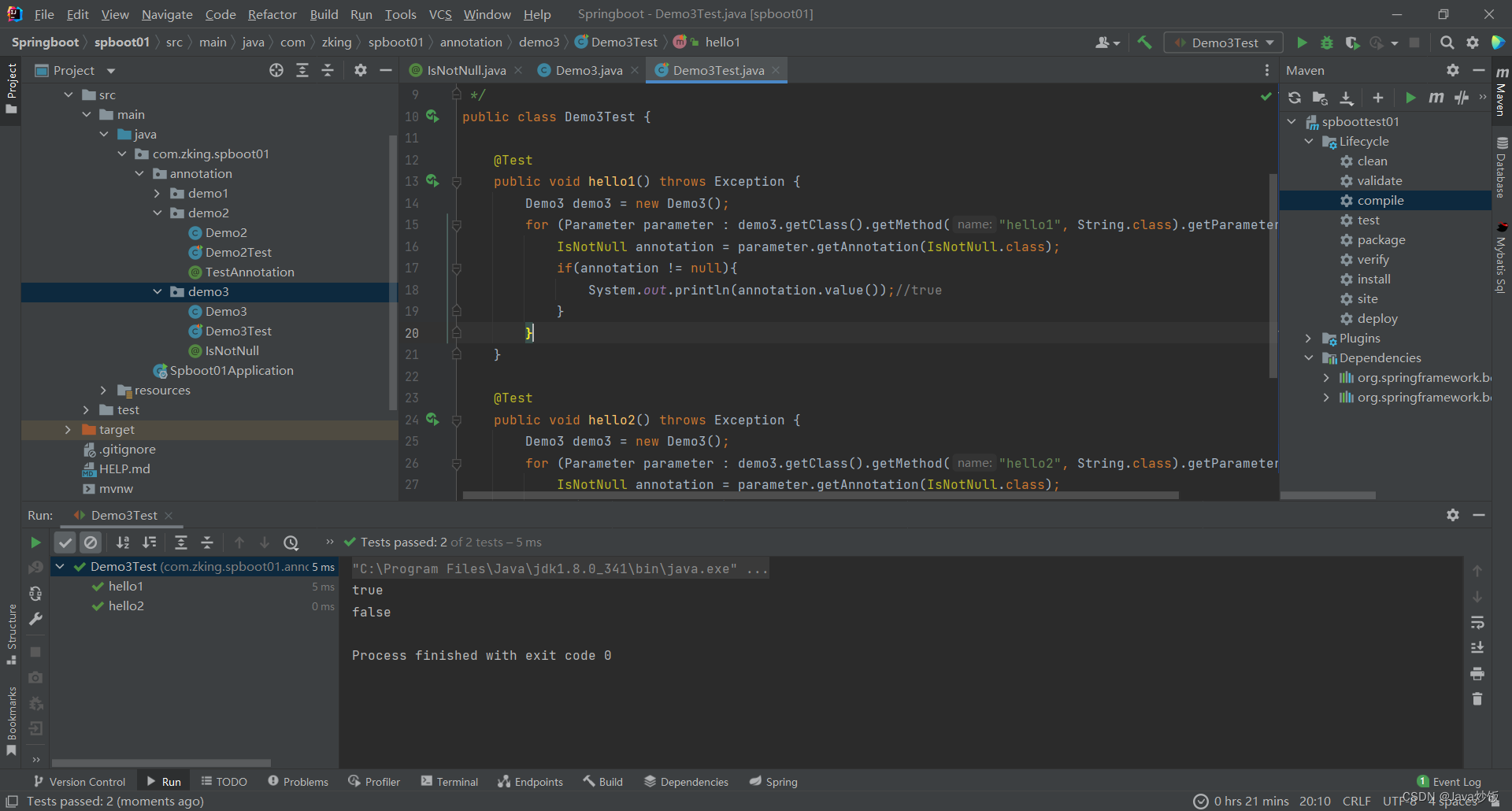
三、spring aop集成自定义注解实现日志记录功能
3.1.在pom.xml中添加依赖
org.springframework.boot spring-boot-starter-aop 3.2.自定义注解
package com.zking.spboot01.annotation.aop; import java.lang.annotation.ElementType; import java.lang.annotation.Retention; import java.lang.annotation.RetentionPolicy; import java.lang.annotation.Target; /** */ @Target(ElementType.METHOD) @Retention(RetentionPolicy.RUNTIME) public @interface MyLog { String desc(); }3.3.定义切面类
package com.zking.spboot01.annotation.aop; import org.aspectj.lang.JoinPoint; import org.aspectj.lang.annotation.Aspect; import org.aspectj.lang.annotation.Before; import org.aspectj.lang.annotation.Pointcut; import org.aspectj.lang.reflect.MethodSignature; import org.slf4j.Logger; import org.slf4j.LoggerFactory; import org.springframework.stereotype.Component; /** */ @Component @Aspect public class MyLogAspect { private static final Logger logger = LoggerFactory.getLogger(MyLogAspect.class); /** * 只要用到了com.javaxl.p2.annotation.springAop.MyLog这个注解的,就是目标类 */ @Pointcut("@annotation(com.zking.spboot01.annotation.aop.MyLog)") private void MyValid() { } @Before("MyValid()") public void before(JoinPoint joinPoint) { MethodSignature signature = (MethodSignature) joinPoint.getSignature(); logger.debug("[" + signature.getName() + " : start.....]"); System.out.println("[" + signature.getName() + " : start.....]"); MyLog myLog = signature.getMethod().getAnnotation(MyLog.class); logger.debug("【目标对象方法被调用时候产生的日志,记录到日志表中】:"+myLog.desc()); System.out.println("【目标对象方法被调用时候产生的日志,记录到日志表中】:" + myLog.desc()); } }3.4.新建LogController
package com.zking.annotation.aop; import org.springframework.stereotype.Component; /** */ @Component public class LogController { @MyLog(desc = "这是结合spring aop知识,讲解自定义注解应用的一个案例") public void testLogAspect(){ System.out.println("这里随便来点啥"); } }3.5.新建LogControllerTest
package com.zking.annotation.aop; import org.junit.Test; import org.springframework.beans.factory.annotation.Autowired; /** */ public class LogControllerTest extends BaseTestCase { @Autowired private LogController logController; @Test public void testLogAspect(){ logController.testLogAspect(); } }3.6.运行结果:
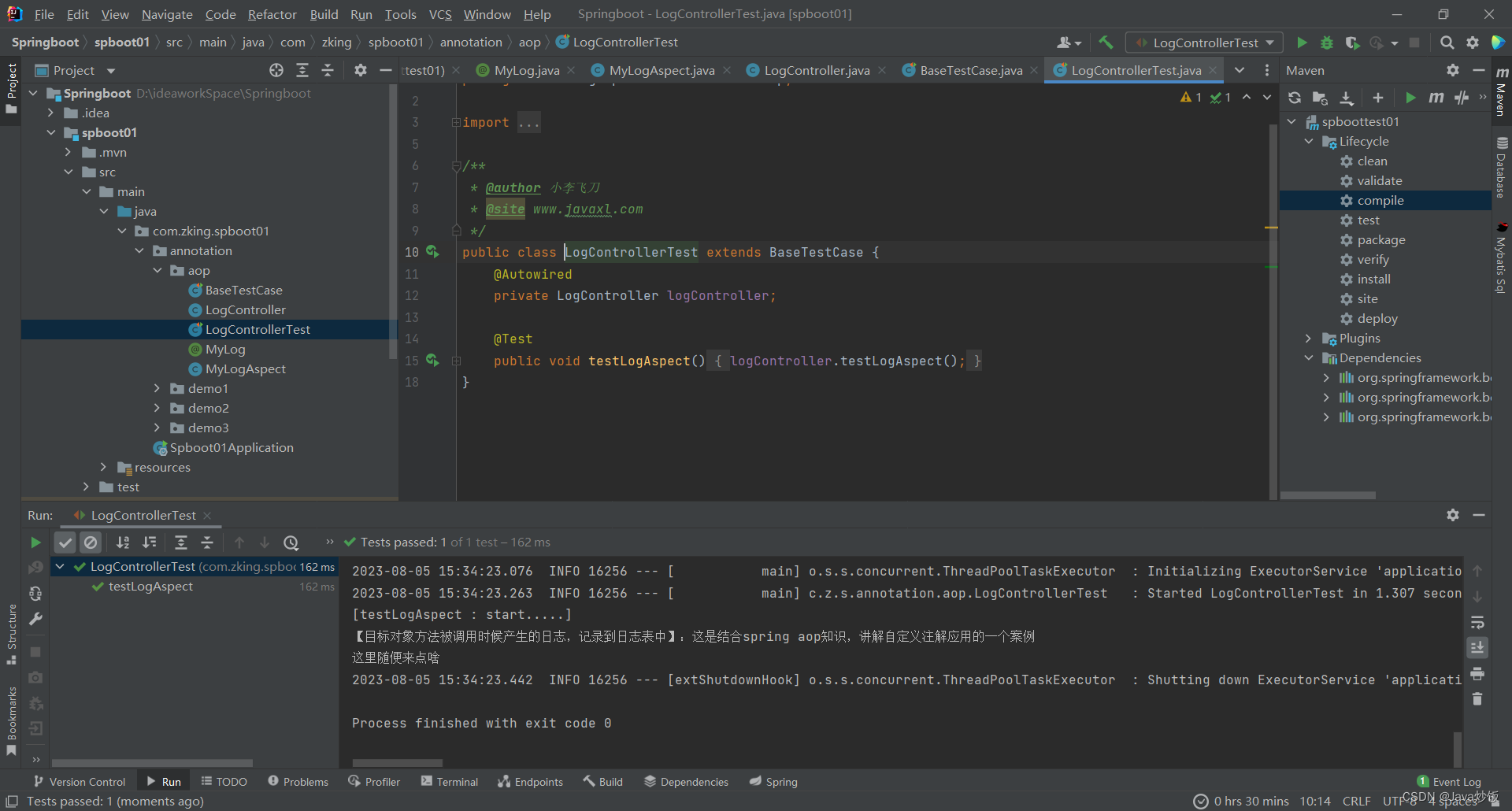
4.6.MyLogAspect中添加内容
@Around("MyValid()") public Object doAround(ProceedingJoinPoint pjp) throws Throwable { long startTime = System.currentTimeMillis(); Object[] args = pjp.getArgs(); System.out.println(Arrays.toString(args)); Object ob = pjp.proceed();// ob 为方法的返回值 System.out.println("耗时 : " + (System.currentTimeMillis() - startTime) + "ms"); return ob; }4.7.修改LogController.java
package com.zking.spboot01.annotation.aop; import org.springframework.stereotype.Component; /** * */ @Component public class LogController { @MyLog(desc = "这是结合spring aop知识,讲解自定义注解应用的一个案例") public void testLogAspect(String name,int age) { try { Thread.sleep(4000); } catch (InterruptedException e) { e.printStackTrace(); } System.out.println("这里随便来点啥"); } }4.8.修改LogConterollerTest.java
package com.zking.spboot01.annotation.aop; import org.junit.Test; import org.springframework.beans.factory.annotation.Autowired; /** */ public class LogControllerTest extends BaseTestCase { @Autowired private LogController logController; @Test public void testLogAspect(){ logController.testLogAspect("零零",20); } }4.9运行结果:

总结
例如:以上就是今天要讲的内容,本文仅仅简单介绍了Springboot的使用,希望对你有所帮助














